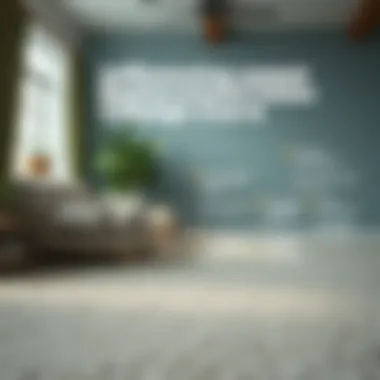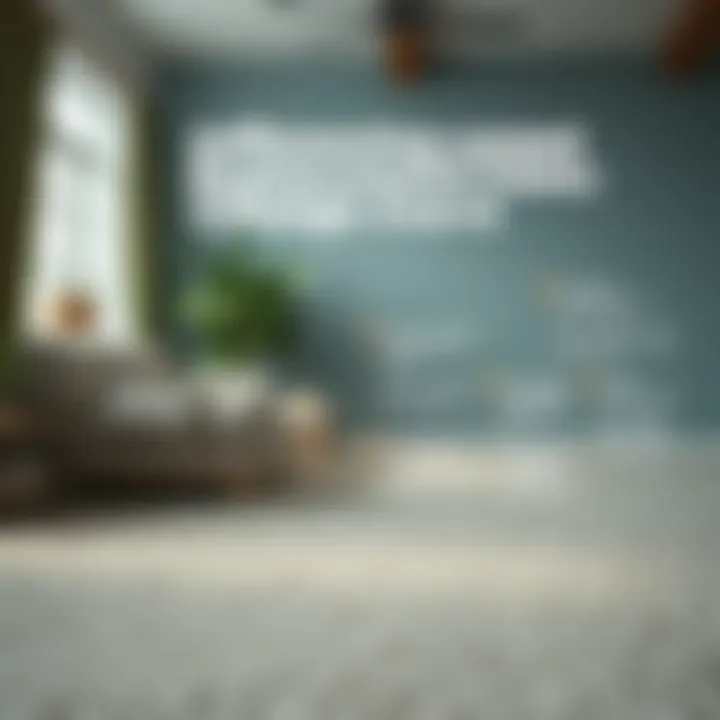Understanding Carpet Replacement Costs: A Complete Guide


Intro
Changing carpets is more than just picking a new look for your floors; it’s a comprehensive decision that ties together aesthetics, functionality, and budget considerations. Homeowners, renters, and even those occasionally hosting parties need to tread carefully on this topic, as the cost can vary significantly based on multiple factors. In this guide, we will venture into the nitty-gritty of carpet replacement, breaking down material choices, labor expenses, and other critical considerations that play a pivotal role in influencing the total cost of the undertaking. Whether you’re after a plush feel underfoot or a durable option for high-traffic areas, understanding these essentials helps developers a well-informed plan, keeping your style fresh while preventing nasty surprises on the bill.
By the end, our aim is to arm you with knowledge, ensuring that you navigate the realm of carpet changes like a seasoned pro. We'll explore everything from your design inspirations to maintenance requirements, providing clarity along the way.
Preamble to Carpet Change Costs
When stepping into a room, the first thing that often catches the eye isn’t just the decor or the furniture, but rather the flooring beneath our feet. Carpets play a significant role in the overall aesthetic and functionality of a living space. Understanding the costs associated with changing carpets may seem simple at first glance, yet it involves a maze of decisions that can impact both your finances and your interior design vision.
An intriguing element is how carpet choices can elevate a home’s ambiance while also reflecting personal style. Carpets are not solely a practical necessity; they contribute to warmth, sound insulation, and even air quality. With this understanding, one can appreciate why deciding to change carpets is no trivial matter.
Considerations like material type, installation method, and even timing can significantly sway the financial implications of this project. Are you opting for a plush nylon option or perhaps a more budget-friendly polyester? Each choice carries its own price tag and performance characteristics, which is crucial to comprehend when diving into the project.
Moreover, understanding the costs involved empowers homeowners to navigate the waters of renovation with confidence. It prevents unwelcome surprises when the bill arrives, ensuring that one can enjoy a lovely carpet without losing sleep over unexpected expenses.
In this guide, we’ll unpack not just the costs but also the pacing of when and how to proceed with such an investment. Understanding carpet change costs isn’t merely about dollar signs; it’s about enhancing your living environment and making informed choices to ensure that your space feels just right.
The Importance of Carpet in Interior Design
To many, the significance of carpet might reside in comfort. However, it branches out much further. Carpets can bolster a room's color palette, ground furniture, and even set the tone for the entire interior space. A well-chosen carpet can transform a mundane room into an inviting sanctuary, making it a vital part of the interior design puzzle.
The tactile and visual elements that carpets offer are testament to their importance. They can soften harsh lines in a room, add layers to your design, and even absorb sounds, creating a cozy atmosphere. In spaces designed for entertaining, like living rooms or dens, a soft carpet can provide a plush surface for guests to relax upon, enhancing the overall gathering experience.
From a practical standpoint, carpets can also define spaces within open-concept designs, offering a visual cue that delineates one area from another. For instance, in a combined living and dining area, a patterned carpet can effectively separate the lounging space from the dining zone, guiding guests through the home seamlessly.
As trends shift, so do carpet styles. From bold patterns to understated elegance, selecting the right carpet can reflect a homeowner’s personality and bring a narrative to the space. It’s enough to say that carpets are not just floor coverings; they're a canvas that tell who you are in your home.
When to Consider Changing Your Carpet
Knowing when to change your carpet can be just as critical as the decision to do so. If your carpet is looking weary, with signs of wear and tear, it may be time to weigh your options. Factors like fading, stains, and fraying edges can signal that the carpet has reached the end of its practical life.
But beyond wear, lifestyle changes often prompt a carpet update. For instance, families with kids or pets may find their carpet absorbing more wear than before, necessitating a more durable material that can withstand their daily antics. On the contrary, if your children are grown and moved out, you might be in the market for a carpet that’s a bit more elegant or serene.
Additionally, changing your carpet can also be tied to trends in interior design. With new colors and textures emerging, a carpet swap may refresh the entire look of your home, making it feel like a brand-new space without extensive renovations.
In some cases, a gradual approach works best. You might decide to do it room by room, especially if you're on a budget. This allows for a coordinated refresh without the immediate financial burden of replacing every carpet in your home at once.
In summary, knowing when and why to make changes is as important as the act itself. Evaluating your current carpet holistically—the aesthetic, functional wear, and even your lifestyle needs—can ensure that each decision made aligns seamlessly with your interior goals.
Factors Influencing Carpet Change Costs
Understanding the factors that affect carpet change costs is crucial for anyone looking to refresh their space. Carpet replacement isn’t just about picking a new design and laying it down. It’s a layered process, encompassing various elements that influence overall cost. From the type of material you choose, to the size of the room, and the labor involved in installation, every detail plays a pivotal role. This section focuses on these vital considerations, allowing you to approach your project with confidence and clarity.
Material Types and Their Price Ranges
When discussing carpet types, it’s essential to recognize how each material differentiates itself in terms of cost and performance. Here’s a closer look:


- Nylon Carpets: Often hailed for their durability, nylon carpets typically range from $3 to $7 per square foot. They can withstand heavy foot traffic, making them ideal for families with kids or pets.
- Polyester Carpets: These are generally more affordable, costing between $2 to $5 per square foot. They’re soft underfoot and come in various styles, but they don’t quite match nylon’s durability.
- Wool Carpets: The luxury turf of carpets, wool can run anywhere from $5 to $15 per square foot. While it’s a hefty investment, it offers unmatched comfort and natural insulating properties.
Each material has its pros and cons, impacting both your wallet and the environment. Consider what fits your lifestyle best.
Room Size and Carpet Quantity
The size of your room directly impacts how much carpet you need to purchase, in turn affecting the overall cost. Here’s how to approach this:
- Measure Accurately: Before you begin shopping, measure your room dimensions carefully. This helps avoid costly miscalculations. It’s common to make adjustments based on furniture layout and flooring preferences.
- Calculating Square Footage: Multiply the length and width to get the total square footage. For example, a room that is 12 feet by 15 feet requires 180 square feet of carpet. Always add extra for waste or future repairs.
- Roll Width Considerations: Most carpets come in standard rolls, typically 12 feet wide. Depending on your layout, you may find yourself buying more than you need. Think about how to maximize coverage from each roll.
Getting the measurements right is the foundation of your budgeting.
Labor Costs and Installation Fees
Labor costs can be as varied as the carpets themselves. Here’s what you need to be aware of:
- Regional Differences: Installation fees fluctuate depending on where you live. Urban areas generally have higher labor costs compared to rural regions.
- Experience Matters: Hiring seasoned professionals might cost more upfront, but their expertise can save you money in the long run by ensuring a proper installation.
- Additional Services: Ask about possible extra fees for moving furniture, removing old carpet, or other added services. These costs can add up quickly, sometimes ranging from $1 to $3 per square foot on top of the carpet material costs.
"When it comes to carpet, the best investment is in installation. A poorly laid carpet can ruin even the finest material."
Navigating through these costs gives you a clearer view of what to expect when changing carpets. Understanding these factors will certainly help you manage your budget better and make informed decisions along the way.
Material Options for Carpet Replacement
Selecting the right material for your carpet is crucial, as it directly affects cost, durability, and overall performance. Whether you have pets that run amok or children who spill juice like it’s going out of style, the material choice can make or break your flooring experience. A well-informed selection not only enhances your space aesthetically but also contributes to the longevity of your investment. Here, we will dissect three prevalent carpet types—nylon, polyester, and wool—highlighting their unique characteristics and implications for your budget.
Nylon Carpets: Durability and Cost
Nylon carpets are akin to the workhorses of the carpeting world, known for their resilience and ability to withstand high foot traffic. When it comes to durability, nylon outshines many alternatives. The fibers are strong, making them resistant to wear and tear, which is particularly beneficial for living rooms and hallways where people frequently shuffle around.
A significant factor to keep in mind is the cost. While nylon carpets tend to fall into the mid-to-high price range, the investment often pays off in the long run due to their longevity. Homeowners can expect to pay around $3 to $7 per square foot, which includes both the material and installation. Another aspect is the ease of maintenance; these carpets resist stains well, especially if treated with a stain repellent. So if spills are a concern, nylon could be your best friend.
Polyester Carpets: Affordability and Performance
Now, let’s talk polyester. If you’re working on a shoestring budget, polyester carpets are often the way to go. These carpets are known for their rich colors and soft feel, making them an attractive option, particularly for bedrooms. They are also less expensive than nylon, with prices typically ranging from $1.50 to $5 per square foot.
In terms of performance, polyester isn’t quite as durable as nylon. However, it has come a long way in terms of stain resistance and performance qualities. Some manufacturers have infused polyester with advanced technologies to improve durability, so it’s worth doing your homework.
While polyester carpets may not be ideal for high-traffic areas, they work wonderfully in low-traffic settings, yielding an aesthetically pleasing finish without breaking the bank. Overall, this option provides a harmonious balance of affordability and performance, especially for homeowners looking to refresh their space without spending a fortune.
Wool Carpets: Luxury and Maintenance
Wool carpets represent the crème de la crème of flooring materials. Their luxurious texture and natural fiber create an ambiance of sophistication. Not only do they provide excellent insulation, but they’re also remarkably resilient, making them a worthy consideration for those wanting to add a touch of elegance to their homes.
However, this luxury comes at a price. Wool carpets can be quite an investment, often commanding between $5 to $15 per square foot, but many appreciate the unique warmth and quality they bring to a space. They also possess inherent stain resistance, thanks to their natural oils, which aid in maintaining cleanliness over time.
On the flip side, maintenance is where wool carpets require a bit more attention. They may need professional cleaning to retain their appearance, especially in high-traffic areas. For those willing to invest in upkeep, wool provides an unmatched level of comfort and style, making it a compelling option for anyone looking to replace their flooring with something truly special.


In summary, each carpet type presents a different set of strengths and weaknesses. Nylon excels in durability, polyester offers affordability, and wool shines in luxury. Understanding these distinctions can guide your decision-making process.
Overall, defining the right carpet material involves weighing your priorities—whether they lean toward durability, cost, aesthetic appeal, or ease of maintenance.
For more details, you can check resources like Wikipedia and Britannica.
The Installation Process Explained
When it comes to changing carpets, understanding the installation process is vital. This phase not only determines the final look of your space but also influences the longevity of your new flooring. Getting this right means you won't have to face any surprises down the line, and it can save you a good chunk of money too. The steps involved in installing new carpeting need to be executed methodically for a successful transformation of your home.
Preparation and Removal of Old Carpet
Before laying down the new carpet, the old flooring must be dealt with. This stage is crucial and involves several important considerations:
- Getting Set Up: Clear the room of all furniture and items. This may not always be a quick task, especially if you’ve got heavy furniture or lots of knick-knacks. Have a plan in place for moving them out—and where you’ll store them during the process.
- Old Carpet Removal: Removing old carpet isn’t just a case of rolling it up and tossing it out. There’s padding, tack strips, and sometimes even glue to consider. Make sure to wear appropriate gear. Dust masks and gloves can make this job a bit easier on your health and safety.
- Inspect Underneath: Take a good look at the floor beneath the old carpet. Any mold, damage, or uneven spots need to be addressed before moving ahead. It’s like finding hidden gems—or avoiding landmines—underneath layers of flooring.
- Disposal: Lastly, dealing with waste is another task. Some local authorities have special disposal sites for carpets, so check the guidelines for your area to ensure you're complying with regulations.
"Preparation can make or break your installation process. Remember, a little planning goes a long way in achieving the perfect flooring result."
Measuring for New Carpet Installation
Once the old carpet is out and the floor is prepped, it’s time to get the measurements right. Accurate measurements will ensure that the new carpet fits like a glove. Here are some key elements to consider:
- Tools of the Trade: You’ll need a tape measure, pencil, and paper. If you want to be tech-savvy, some apps can help with measuring.
- Measuring Method: Measure the length and width of the room. Don’t forget to factor in closets or alcoves. Always record your measurements in feet and inches to keep it clear.
- Account for Waste: When ordering carpet, suppliers usually recommend adding around 10% for waste. This accounts for possible mistakes and cuts, so you won’t be running around last minute looking for matching carpet.
- Note Doorways and Features: Be sure to measure around door frames and any other architectural features. This often-overlooked step prevents awkward seams and mismatched patterns.
Actual Installation Steps
Finally, we arrive at the main event—the installation of the new carpet. This task is best left to professionals if you're unsure, but if you choose to go the DIY route, here’s how to proceed:
- Underlayment Installation: If you're using an underlayment, it needs to be rolled out first and secured in place. This layer can promote comfort and cushioning, so don’t skip it as it can enhance the overall feel.
- Cutting the Carpet: Roll out the new carpet and cut it to size, allowing a bit of extra length to work with. A carpet cutter or utility knife can do the trick, but take extreme care while doing this.
- Securing the Edges: Attach the carpet to the tack strips around the perimeter of the room. Stretch it firmly and attach with a carpet stretcher to prevent any loose areas which might be uncomfortable or prone to damage.
- Finishing Touches: Pay close attention to seams. The way you join two pieces of carpet impacts not only the appearance but also the durability. You may consider using seaming tape or adhesive for a cleaner, sturdier finish.
- Final Inspection and Cleanup: Before rolling out the welcome mat for unsuspecting visitors, clean up the area. Look for any loose pieces, bumps, or misaligned sections.
By understanding and tackling each of these stages with care, you can elevate the look of your interiors while avoiding potential pitfalls. Knowing what’s involved in the installation process can empower homeowners to either approach it themselves or have an informed conversation with contractors.
Budgeting for Carpet Change
When the time comes to replace your carpet, getting a good grip on how much it’s gonna cost is crucial. You don’t want to be caught off guard, like a deer in headlights, halfway through the process. By budgeting wisely, you can lay out a clear path that leads to not only satisfaction with your choice of flooring but also ensures you’re not breaking the bank in the process. It’s not just about the initial cost; understanding the full financial picture can save you time and headaches down the road.
Creating a Cost Estimate
Creating a solid cost estimate involves looking at several components that all add up. You need to tally up the price of the carpet itself, the installation fees, and even some extra costs you might not have thought of. Here are some essentials to keep in mind when making your estimate:
- Carpet Pricing: Depending on your selection of fibers and style – from durable nylon options to luxurious wool – the price can vary significantly.
- Room Size: Consider the square footage of the area you’re covering. More space means more carpet, and thus a heftier bill.
- Installation Costs: Typically, you’ll be paying per square foot for installation. If you’re looking at complex layouts or stairs, these factors will lift the price.
- Removal of Old Carpet: If you need to take out the old carpet, account for labor involved here too.
- Padding Needs: New carpet often requires new padding, which can add to your expense.
A rough estimate of your overall budget can be compiled by taking each of these factors into account and adding them together. Some homeowners prefer to use online calculators provided by home improvement stores, which can give a nice starting figure but might vary depending on local labor rates.
Unexpected Costs and How to Mitigate Them
Life is unpredictable, and the same goes for carpet changes. It’s easy to overlook certain costs that pop up unexpectedly.


To minimize surprises, consider the following:
- Hidden Damage: Before laying new carpet, inspect the subfloor. Rot or water damage could mean repairs before you proceed, adding unexpected costs.
- Upgrades in Materials: If you’ve set your heart on something specific, say a high-quality carpet pad or a particularly lavish carpet, you need to be ready for the potential for a price increase.
- Miscellaneous Fees: Sometimes, there are fees related to moving furniture or disposal of old materials that you might not think to include in your budget. Check the fine print.
To mitigate these kinds of costs, be thorough in your planning and upfront with your installers. Always ask for detailed quotes and don’t shy away from discussing potential issues on the horizon that could alter your budget. Being mindful of these aspects can save you from stepping into a financial quagmire.
Remember: A well-planned budget is your best defense against sudden expenses in carpet changing.
Long-Term Considerations
When thinking about changing carpets, long-term considerations cannot be brushed under the rug. It's easy to focus solely on the upfront costs and aesthetics, but what about how the carpet will stand the test of time? Choosing the right carpet isn't just about looks; it's an investment that impacts your home for years down the line. Neglecting long-term factors could lead to frustrations and regrets down the road.
Carpet Lifespan and Maintenance
The lifespan of a carpet largely depends on its material, quality, and how well it's maintained. Generally, you can expect a carpet to last anywhere from five to fourteen years. Here are some factors to consider:
- Material Quality: High-quality materials like wool or nylon often last longer than budget-friendly polyester options.
- Traffic Levels: Carpets in high-traffic areas, such as hallways and living rooms, tend to wear out faster, requiring more frequent replacements.
- Maintenance Routines: Regular vacuuming and professional cleaning every few years can extend the life of your carpet significantly.
Understanding the maintenance requirements for different carpet materials is crucial. For instance, wool carpets require more care and attention, while synthetic fibers might just need a good vacuum and an occasional steam clean.
“Investing in quality maintenance can double the lifespan of your carpet.”
Sustainability in Carpet Choices
Sustainability is becoming a pressing concern in many households. As more people strive to reduce their carbon footprint, the decision to choose eco-friendly flooring options is gaining traction. Sustainable carpets can come in a variety of forms, such as those made from recycled materials or those that are biodegradable. Consider these aspects:
- Material Origins: Look for carpets made from renewable resources like sisal or jute. These materials have a much lower ecological impact than synthetic fibers.
- Production Processes: Opt for manufacturers who adhere to environmentally-friendly practices. Certifications such as Green Label Plus ensure lower emissions during production.
- End-of-Life Considerations: It's essential to think about what happens to your carpet after its lifecycle. Choosing products that are either recyclable or biodegradable can lessen waste.
Incorporating sustainability into your choices goes beyond mere aesthetics; it reflects values and commitment to the environment. Not only can sustainably sourced carpets provide you peace of mind, but they are also becoming fashionable in contemporary interior design.
When considering changing carpets, always take a moment to reflect on how your choices will affect not just your home, but also the planet. Thoughtful choices today can lead to a greener tomorrow.
End: Making Informed Carpet Choices
In the realm of home improvement, making informed choices about carpet selection is paramount. The process can often feel overwhelming, especially with a myriad of decisions regarding materials, costs, and long-term implications on aesthetics and functionality. This guide has cast a spotlight on various factors that play into the overall expense of changing carpets, underscoring the significance of approaching this task with knowledge and foresight.
Understanding the Importance: Each homeowner or renter should consider their unique environment and personal style preferences when selecting new carpeting. The right carpet can completely transform a space, but it’s essential to also weigh factors like foot traffic, maintenance needs, and durability against the backdrop of initial investment. Choosing wisely, backed by thorough research, isn’t just beneficial for aesthetics; it sets the stage for cost efficiency long-term.
"A well-chosen carpet is not just a purchase; it’s laying the groundwork for your home’s atmosphere."
The information provided in this article encourages readers to prioritize these choices, ensuring they tailor their decisions to align with their lifestyle and budget. By understanding the diverse materials available, assessing the hidden costs associated with carpet installation, and considering sustainability, homeowners can avoid common pitfalls. Overall, knowledge is power when it comes to making flooring decisions that will influence the comfort and visual appeal of living spaces.
Summarizing Key Takeaways
To distill the essence of what has been discussed, here are some key points to consider:
- Material Matters: Different carpet materials carry varied costs and maintenance considerations. For instance, while wool offers luxury, synthetic options might provide better durability for heavy use.
- Installation Costs Vary: Factor in labor and additional expenses during installation. An accurate assessment early on can save headaches later.
- Long-Term Value: Investing in quality can often complement your home’s value. Cheaper carpets may need replacing sooner, making them a false economy.
- Maintenance Is Key: Understanding the required upkeep for your chosen material helps maintain its appearance and life span over time.
By reflecting on these points, you can approach your decision-making process with clarity and confidence.
Final Thoughts on Cost-Effective Carpet Alternatives
Not every homeowner needs to break the bank when changing carpets. There exist various cost-effective alternatives that fulfill aesthetic and functional requirements without skimping on quality. Consider carpets made from recycled materials, which not only reduce waste but also often come at a competitive price point without compromising durability.
Additionally, exploring options like carpet tiles or modular carpeting can be quite resourceful. These allow for easy replacement of sections that bear the brunt of wear—an economical strategy that offers customization and ease of repair.







